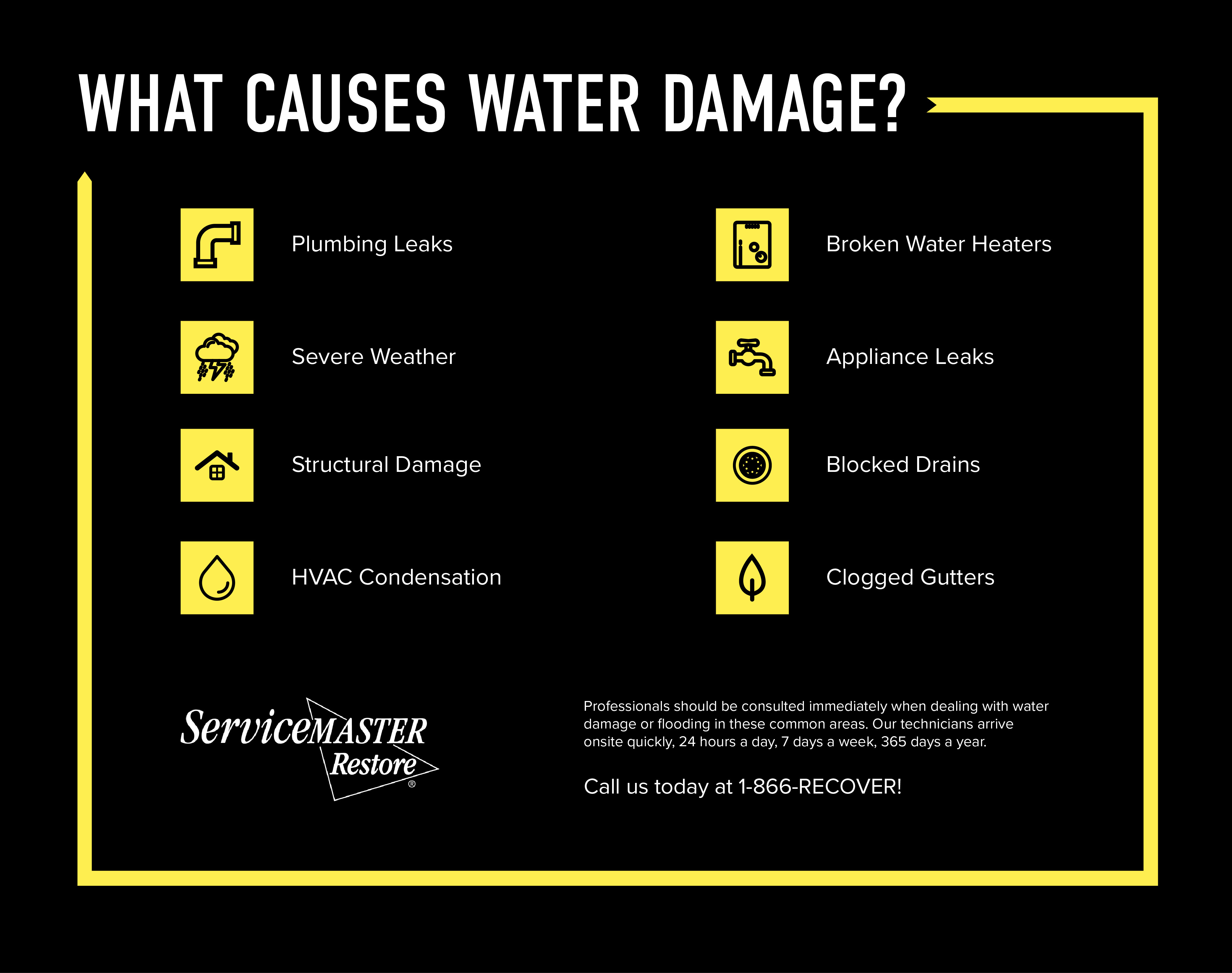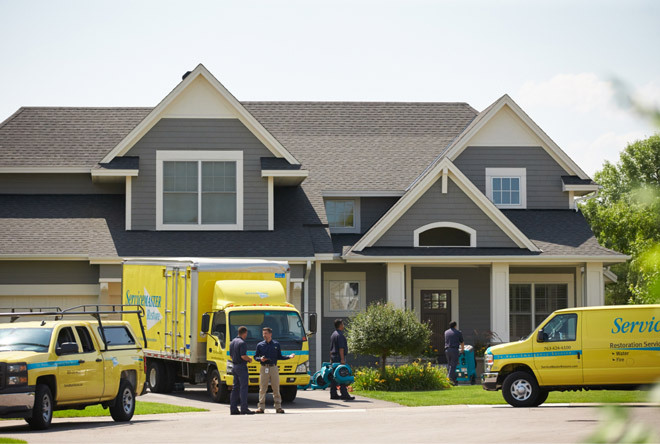Water Damage Restoration in Willmar, MN
Flood Cleanup from Certified Experts
 Just about every home and business in the state of Minnesota will eventually be a victim of water damage due to our wet local climate. The onslaught of rain, flood, and humidity alongside issues like leaks and burst pipes are a few reasons why home water damage restoration is a much needed industry in the region. Water damage can be deceiving because it gets absorbed into the building materials and furnishings which makes even minor damage a potentially major problem without the proper action. ServiceMaster Professional Services provides water damage restoration services in Willmar, MN to remove water and moisture from homes and buildings as well as clean up and repair the damage. Our technicians are on call 24 hours a day, 7 days a week, 365 days a year to respond to water damage emergencies.
Just about every home and business in the state of Minnesota will eventually be a victim of water damage due to our wet local climate. The onslaught of rain, flood, and humidity alongside issues like leaks and burst pipes are a few reasons why home water damage restoration is a much needed industry in the region. Water damage can be deceiving because it gets absorbed into the building materials and furnishings which makes even minor damage a potentially major problem without the proper action. ServiceMaster Professional Services provides water damage restoration services in Willmar, MN to remove water and moisture from homes and buildings as well as clean up and repair the damage. Our technicians are on call 24 hours a day, 7 days a week, 365 days a year to respond to water damage emergencies.
We react quickly to your call and arrive on the scene with the best drying equipment and cleaning products available to deal with water losses of any size in commercial and residential settings. With our advanced flood cleanup and drying equipment, we can effectively remove water from the structural elements, furnishings, and content in your home.
What to Do in Case of Water Damage
- Immediately call SVMPS to stop the spread of the water damage which will save time and money on the restoration and prevent mold growth.
- Remove excess water by mopping and blot drying.
- Remove temporary floor coverings such as wet area rugs.
- Put drapery bottoms through a coat hanger and put the hanger on the rod to keep draperies off the floor.
- Wipe off excess water from furniture and prop up the cushions for even drying.
- Put paintings, photos, and similar objects in a safe location.
- If your books are damaged, keep them packed together tightly on the shelves to avoid page warping until they can be treated with our specialized drying process.
- Open up doors, windows, internal doors, and cabinet doors and drawers to help with drying.
What NOT to Do in Case of Water Damage
- Do not walk into a room with standing water unless the power is turned off.
- Do not use a normal household vacuum cleaner to remove water.
- Do not remove permanent flooring, leave this to a professional.
- Do not use electrical appliances while standing on a wet floor.
- Do not disturb mold or mildew growth, this is also best left to professionals.
Reacting quickly to water damage is important because it can get absorbed in building materials such as drywall, insulation, wood, and others that allow it to spread throughout the home or building. This results in widespread structural damage and greatly raises the risk for mold growth. We will help mitigate the damage so that it does not spread to unaffected areas and completely extract all water and moisture from absorbent materials with our specialized drying equipment. Our flood cleanup technicians provide the following with our water damage restoration services:
- Complete evaluation of the damage
- Removal of excess water and moisture
- Anti-microbial application
- Drying: air movement
- Drying: dehumidifying
- Drying: monitoring
Water damage can quickly become a much bigger problem without prompt action so call ServiceMaster Professional Services for flood cleanup as soon as you discover water damage in your home or business in Willmar, MN.
Is water damage restoration covered by homeowners insurance?
Homeowners insurance may cover water damage restoration, but it depends on the cause of the damage and the specific terms of the policy. Here are some key points to consider:
1. Covered Causes of Water Damage: Most standard homeowners insurance policies cover sudden and accidental water damage, such as damage caused by burst pipes, appliance malfunctions, or water heaters. If the damage was unexpected and beyond the homeowner's control, it’s likely to be covered.
2. Excluded Causes: Gradual or long-term water damage, such as from poor maintenance, slow leaks, or wear and tear, is typically not covered. Issues like mold, rot, or rust, which often result from neglected leaks, are usually considered the homeowner’s responsibility.
Damage from flooding (natural disasters, rising river water, etc.) is generally not covered under standard homeowners insurance and requires separate flood insurance.
3. Sewer Backup or Overflow Coverage: Many standard policies do not cover damage from sewer backups or overflows unless specific "water backup" coverage is added to the policy. This endorsement can usually be purchased for an additional premium.
4. Additional Living Expenses (ALE): If water damage makes the home uninhabitable, many policies cover additional living expenses, like hotel costs and meals, while repairs are being made.
5. Filing a Claim: Promptly notifying your insurer, documenting the damage, and keeping receipts for any emergency repairs can help with the claims process. It’s also essential to stop further damage, as policies generally require homeowners to take reasonable steps to protect the property from worsening.
It’s always a good idea to review your specific policy or consult with your insurance agent to understand what water damage situations are covered and to consider additional endorsements if needed.
Yes, homeowners insurance often covers certain types of water damage, but coverage depends on the cause and specifics of the damage. Here’s a breakdown of when water damage is typically covered and when it isn’t:
1. Covered Water Damage (Sudden and Accidental)
Burst Pipes and Appliance Failures: Homeowners insurance typically covers sudden and accidental water damage, such as from a burst pipe, an overflowing washing machine, or a broken dishwasher. If this type of water damage is covered, the policy generally pays for both the repairs to your home and related water damage restoration services.
Rain or Snow Damage: If rain or snow enters your home due to storm damage (like a tree falling on the roof), your policy typically covers the resulting water damage.
2. Not Covered: Gradual or Maintenance-Related Damage
Slow Leaks and Maintenance Issues: Damage from gradual leaks or long-term maintenance issues, such as a slow roof leak, poorly maintained plumbing, or gradual wear on appliances, is typically not covered. Insurance providers expect homeowners to maintain their property, so issues that develop over time or from lack of upkeep are considered the homeowner’s responsibility.
Mold Damage: While sudden water damage may be covered, mold that develops from a gradual leak or poor ventilation often is not. Some policies offer limited mold coverage or an optional endorsement for additional mold protection.
3. Flood Damage
Flooding from Natural Events: Standard homeowners insurance does not cover flood damage from natural events, such as river overflows, flash floods, or storm surges. To protect against flood damage, homeowners need a separate flood insurance policy, available through private insurers or the National Flood Insurance Program (NFIP).
4. Water Backup Coverage
Sump Pump and Sewer Backups: Many standard policies do not include coverage for damage caused by sewer or sump pump backups, but homeowners can usually add a water backup endorsement for this. This optional coverage can help cover damage and restoration costs if water backs up through drains, sewers, or sump pumps.
5. Additional Water-Related Coverage Options
Some insurers offer additional endorsements that extend coverage for things like mold remediation, gradual water damage, or high-value items that might be affected. Reviewing and understanding your policy’s specific coverages and endorsements can help ensure you’re covered for a range of potential water-related issues.
Homeowners insurance typically covers water damage that is sudden and accidental, like burst pipes or storm-related leaks, but not gradual damage from poor maintenance or flood events. For flood and water backup protection, additional policies or endorsements are required.
We are standing by to respond quickly to help mitigate water damage and remove excess water with our advanced drying equipment. Our phone lines are open 24 hours a day at (320) 348-7792.
 Just about every home and business in the state of Minnesota will eventually be a victim of water damage due to our wet local climate. The onslaught of rain, flood, and humidity alongside issues like leaks and burst pipes are a few reasons why home water damage restoration is a much needed industry in the region. Water damage can be deceiving because it gets absorbed into the building materials and furnishings which makes even minor damage a potentially major problem without the proper action. ServiceMaster Professional Services provides water damage restoration services in Willmar, MN to remove water and moisture from homes and buildings as well as clean up and repair the damage. Our technicians are on call 24 hours a day, 7 days a week, 365 days a year to respond to water damage emergencies.
Just about every home and business in the state of Minnesota will eventually be a victim of water damage due to our wet local climate. The onslaught of rain, flood, and humidity alongside issues like leaks and burst pipes are a few reasons why home water damage restoration is a much needed industry in the region. Water damage can be deceiving because it gets absorbed into the building materials and furnishings which makes even minor damage a potentially major problem without the proper action. ServiceMaster Professional Services provides water damage restoration services in Willmar, MN to remove water and moisture from homes and buildings as well as clean up and repair the damage. Our technicians are on call 24 hours a day, 7 days a week, 365 days a year to respond to water damage emergencies.

